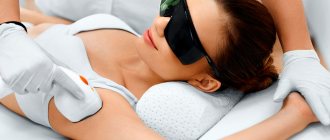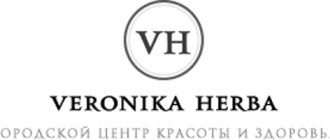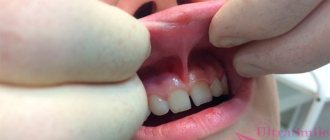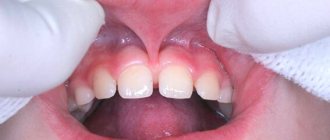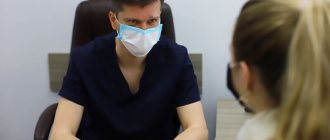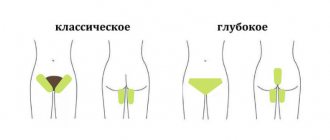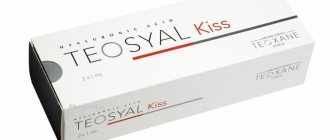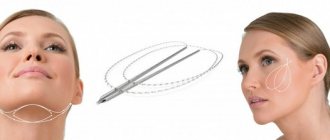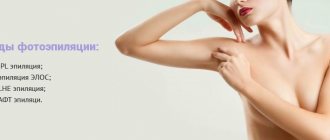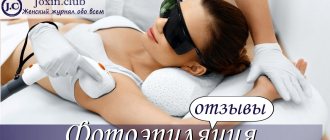- Why do women get hair on their upper lip?
- What do you need to know before the hair removal procedure?
- Photoepilation of the upper lip: how does the session work?
- Advantages of this technique
- Are there any contraindications for photoepilation of the upper lip?
- Are complications possible after photoepilation?
- How to care for your facial skin after photoepilation of the upper lip?
- Photoepilation of the upper lip video
- Photoepilation of the upper lip before and after photos
- Location of our clinic (facade of the building)
- Clinic equipment
- Clinic interior
- How to make an appointment at the Absolut Med LLC clinic?
Absolut Med LLC is a modern Moscow aesthetic cosmetology clinic. We offer photoepilation services in the upper lip area using the most modern European-made equipment (Ellipse Flex PPT device). We have certificates for providing such services and a sufficient number of highly qualified specialists.
Photoepilation of the upper lip: how does the session work?
The number of procedures is calculated individually. To eliminate hair above the lip you will need to use at least 15 flashes.
Photoepilation of the upper lip lasts approximately 10 – 15 minutes.
- The patient is given protective glasses before skin treatment.
- Then the skin is cleaned of impurities and degreased.
- After this, a gel with a cooling effect is applied.
- After the procedure, the skin is also moisturized with a special cream.
During the procedure, the person feels very warm. Most patients do not experience significant pain. To reduce pain, the doctor may change the equipment settings.
A few days after the first session, hair will begin to fall out. However, they will not be completely removed. Some of the hair will become more brittle and weaker.
A full course of 4 to 10 sessions will allow you to completely get rid of unwanted facial hair.
There should be a break of at least a month between procedures.
What is facial photoepilation
Properly performed photoepilation ensures the death of not only the follicle, but also the hair papilla. During the procedure, the problem area of the skin is treated with light flashes (based on the number of hairs). The radiation only affects dark vegetation that contains the coloring pigment melanin. Light energy in the hair shafts is converted into heat and causes the temperature at the root to rise to 80 °C. The follicle gets burned, the capillaries become clogged, the blood supply becomes difficult, and the bulb atrophies over time.
Radiation affects hairs that are in the active growth phase
Restoration of hair growth in the treated area is possible, but it does not occur as quickly as with conventional depilation. Within a week or two after the session, some of the irradiated hairs fall out (about 20–30% of the total area of the problem area). The course of therapy ranges from two to twelve procedures. With regular treatment, the hairs gradually become thinner and lighter, so they are much less noticeable.
Experienced patients say that after deciding to have facial hair removal, you need to carefully choose not only the method of doing it, but also the place. The success of the procedure largely depends on the professionalism of the staff.
On a note. Real customer reviews and a preliminary consultation with a salon dermatologist will help you make the right decision about photoepilation.
How to prepare for a session
Before photoepilation at home, apply sunscreen with an SPF 30+ filter to the skin. There is a special cooling gel in the salons. The procedure is performed only on light skin (possibly with a slight tan) and on dark hair. On light colors, it will not only not give results, but can also cause burns.
It is better to sign up for the first photoepilation sessions in early autumn in order to achieve complete relief from the problem by the end of winter. The intervals between procedures can take several weeks, and the overall course is quite long. In order not to put it off until spring-summer, when it is very easy to tan and harm your skin, it is better to take care of visiting the salon in advance. You should refrain from solarium procedures about two weeks before the start of the photoepilation course. Otherwise, there is a risk of getting discolored spots and hypopigmentation on tanned skin.
A month before photoepilation, refuse any other hair removal procedures except shaving. By the appointed day, the length of the hairs should be approximately 2 mm.
In preparation for the procedure, visit a dermatologist; young girls are also recommended to visit an endocrinologist. Some also turn to a gynecologist. Sometimes even a preventive examination and subsequent treatment can get rid of the problem without spending extra money on photoepilation.
Equipment settings are individual for each patient. The dermatologist will determine the general condition of the skin and give the specialist recommendations for the procedure. As prescribed by a doctor, it is possible to use antiviral drugs, for example, to avoid relapse of herpes.
Preparation for photoepilation includes a mandatory medical consultation with a dermatologist-cosmetologist
Progress of the procedure
During the procedure, the client and the master wear protective glasses. Photoepilation involves targeted irradiation of the area where excess hair grows with an intense light flux. A facial photoepilation session takes about 5–10 minutes due to the small treatment area. Hair falls out not during the procedure, but after about three weeks. After this period, new follicles “wake up” and the patient is prescribed a repeat procedure.
Video: facial hair removal in the salon
What devices are used
In theory, photoepilation can be done at home. The devices are produced not only in special and expensive versions that are purchased by beauty salons, but also in the form of compact devices for home use. Each device is equipped with a double filter that protects the skin from too intense irradiation. The screen through which the directed flow of energy is transmitted is small. It is easy to handle even individually growing hairs.
With compact models of photoepilators you can perform the procedure yourself
IPL technology
The technology for transmitting a powerful light pulse, encrypted with the abbreviation IPL, belongs to the Israeli company Lumenis Ltd. Manufacturers use light energy from krypton lamps in their devices, emitting waves at a frequency of 500–1200 nm. Ultraviolet light, which is harmful to the patient, spreads in this range, so the devices are equipped with filters made of special protective glass.
The working life of the released models is different, measured by the number of flashes. An average-cost device can have approximately 50–80 thousand of them. With constant use of the unit, the working resource can be exhausted in about a year, then the lamp needs to be changed.
The following photoepilators are suitable for use at home:
- Remington IPL5000;
- HPLight;
- Remington IPL6000;
- i-Light Pro.
Professional equipment is represented by the following models:
- Skin Station Mistral is a multifunctional light-thermal system that provides a full range of services: removal of unwanted hair, skin rejuvenation, treatment of acne, psoriasis;
- Ellipse Light is a device with double filtration;
- Classic 512 - professional equipment for photoepilation and photorejuvenation;
- Record 618 is a photoepilation device that is designed for any skin type and hair structure;
- Quantum IPL, Quantum HR/SR - equipment capable of generating a spectrum of waves, allowing you to change the number of pulses, the intervals between them and the duration of the flash;
- Lumenis One is a device that has permission for use from the European Union and is registered with the Russian Ministry of Health.
Video: is photoepilator really effective?
How to care for your facial skin after photoepilation of the upper lip?
In order for rehabilitation to proceed faster, it is important to ensure proper facial skin care.
- Avoid visiting saunas and steam baths for a while
- Do not swim in the sea, river, lake or other bodies of water.
- Do not sunbathe or visit a solarium.
- Avoid washing your face with hot water
- Temporarily do not apply cosmetics
- Do not use aggressive products for deep cleansing of facial skin for some time.
- If you did photoepilation in the summer, then try not to be outside for a long time for the first three days. If you must go out in the sun, use a hat or sunscreen.
Advantages and disadvantages of the procedure
An objective assessment of the results of photoepilation is possible only when it is carried out in a salon by a specialist with experience. The absence of contraindications is important for the patient. It should be noted that the result of the procedure is not immediately visible, but this does not apply to its disadvantages. Similar technologies using light and thermal flashes also have a delayed effect. However, this procedure has a few disadvantages:
- you can get superficial burns, especially if the skin is tanned;
- photoepilation is only suitable for dark hairs containing a large amount of melanin.
At the same time, there are more positive aspects to using the device:
- the skin is minimally injured, especially if a real specialist takes on the matter;
- there is no risk of getting an infection during the procedure;
- photoepilation takes a minimum of time;
- the use of the device provides an additional effect of skin rejuvenation;
- After the procedure, ingrown hairs do not appear.
The procedure can indeed be painful, but not for everyone—people usually get used to it after the second session. Patients with sensitive skin and a low pain threshold feel the thermal effect.
Table: comparison of different hair removal technologies
| Comparison criteria | Electrolysis | Laser hair removal | Photoepilation |
| Duration of the procedure | 20–40 minutes | From 2 to 50 minutes | 15–20 minutes |
| Cost of the procedure | 20–30 rub./minute (depending on the epilation area) | 1.5–10 thousand | 5–30 thousand (price in showrooms is for 1 flash) |
| Course duration | 15 sessions | 10–18 sessions (depending on hair removal area) | 5–12 sessions |
| What areas can be treated | Treatment of hairs in the nose and ears is prohibited | Any | Any |
| Absolute contraindications | Allergy to metals | Oncology, not performed on blond and gray hair | Tanning, dark skin, malignant tumors |
| Result | Removes all types of hair | Does not give effect when treating light, gray, vellus hair | Suitable for dark hair only |
Differences
Laser and photoepilation differ in several ways:
— on the hardware component; — by the method of influence; — by the number of necessary procedures and their duration; - for the cost of one session.
Laser or photoepilation - which is better according to the method of exposure? The second type of procedure according to this criterion is the most universal. It uses one device capable of combining different types of light radiation. During laser hair removal, a specific type of device is selected. This is done depending on the color of the skin and hair.
The choice between laser and photoepilation is also made regarding the design of the devices used. They are arranged differently. Thus, in equipment for photoepilation, the entire spectrum of radiation is combined in a working attachment. This allows you to increase the area of the treated area. Manipulations with a laser device are carried out under the influence of one beam. In this regard, the area covered is not very large. However, with this type of procedure, the beam affects the skin with greater power.
How it happens
A mustache photoepilation session for women begins with an examination by a cosmetologist of the area that needs this procedure.
He asks about your medical conditions and what medications you are taking. Determines your skin type as well as hair shade. Tells you information about the number of sessions, the preparation process and the rules of behavior after the session. Did you know?
Photoepilation does not work on blond or gray hair, since they do not contain melanin.
First, you will be given special glasses to protect your eyes from the harmful effects of the device. The procedure is a series of flashes that destroy the hair follicles. The procedure is painless, sometimes there may be a slight burning sensation, which quickly passes. During the process, the doctor applies a special product to the treatment area that softens and protects the skin.
Consequences and side effects
Immediately after the procedure, you may experience approximately the same sensations as after a minor burn. Redness and slight swelling are often noted. These symptoms should disappear within a few days if you take proper care of your skin:
- avoid all water treatments for a week;
- protect skin from the sun;
- use decorative cosmetics to a minimum.
Complications can be identified immediately after the first procedure:
- skin burn if the outbreak was too strong or the patient has very sensitive skin;
- allergies, the symptoms of which are itching or signs of dermatitis.
After the first procedure, you may notice severe swelling, redness or itching.
Other diseases may appear during and after a course of photoepilation:
- hypo- and hyperpigmentation;
- eye diseases and impaired visual acuity, if there was no protection with glasses or special metal lenses;
- the appearance of scars;
- increased hair growth (after the procedure due to insufficient radiation power);
- in rare cases - graying of hairs;
- inflammation of the hair papilla (folliculitis);
- melanoma formation.
Video: complications after hair removal
Number and cost of sessions
The benefit of laser hair removal is its ability to treat every follicle. This allows you to get the desired result in fewer procedures. But from the point of view of the duration of sessions, laser removal of unwanted hairs is inferior to photoepilation. It is carried out for fifteen minutes.
As for the cost, both methods are not cheap. However, laser hair removal costs about half that (around fifty dollars per session).
It is up to the client to decide which method to choose. The result with both procedures will be approximately the same.
Preparation
First of all, you will need to undergo an examination by a dermatologist. He will determine whether such a procedure can be performed on a woman, and whether exposure to light rays will cause a negative effect on the body.
The doctor will not allow girls with dark skin to undergo the procedure. Removal is allowed 14 days after the last sunbathing.
Another condition for admission to the procedure is the size of the hair shoots; normally it should be no more than 2 mm, that is, immediately before removal by photoepilation, you need to shave off unwanted hairs. You should not take antibiotics or sedatives before this procedure.
Reviews about the pros and cons of the procedure
The upper lip, chin, etc. are the so-called hormonal zones. You will NEVER remove hair from it forever. For 8 years too, I think. These zones have to be maintained constantly, but personally I recommend the alexandrite laser, because... photoepilation can leave burns (I had)
Ellen
https://www.woman.ru/beauty/medley2/thread/3952371/
Girls, better get tested for male hormones and go to a gynecologist for treatment with this problem. if hair grows on the face, then you need to correct your hormonal levels - and a gynecologist will help you with this better than any cream and the result will last longer and there will be more benefits for the whole body... and it costs several times less than photoepilation.
Belz
https://www.woman.ru/beauty/medley2/thread/3952371/
About 4 years ago I had photo-epilation of the mustache above my upper lip. I myself am brown-haired, so my hair is black and quite coarse. After the examination, the doctor prescribed 10–12 photoepilation procedures for the complete destruction of hair follicles. The result is that photoepilation helps get rid of excess hair, but for a short (relative to pain) time, hormonal changes in the female body affect these processes. I recommend photoepilation, but with a caveat - you don’t get rid of hair forever!
GRILEK
https://irecommend.ru/content/fotoepilyatsiya-proshlo-4-goda
I will write about my experience of photoepilation. I decided to try it on my face first, so as not to waste money) the prices are amazing for this procedure (in Moscow time). I found a more decent salon - I chose from the nearest ones. For the first time I wanted to remove the frizz from my upper lip. In total, I needed 4-5 flashes the first time. Then the gel is washed off, a protective cream is applied and that’s it. The only recommendation is not to go to the solarium and not to sunbathe for a long time, so as not to burn the skin that has undergone photoepilation. Next, the cosmetologist recommended that the next day at home I try to gently pull out the hairs (namely pull out, those that are pulled out without pain, and not pull them out!) or rub a little with a scrub (not too much!), but I did practically nothing, because after a few days I already had absolute smoothness above my upper lip. The effect lasted for a month and a half, then I went again. Over the course of six months, I did three procedures and now, after another half a year, I just want to go one more time, but there are practically no hairs there.
ZimniyVecher
https://irecommend.ru/content/vse-zavisit-ot-apparata-i-ot-mastera
The skin of the face is very sensitive, so any procedures in this area should be extremely gentle and non-traumatic for the woman. Modern photoepilation technology helps remove unnecessary and unsightly hairs in this area. With the right approach to solving the problem, you will definitely get a positive result.
- Author: woman
Rate this article:
- 5
- 4
- 3
- 2
- 1
(2 votes, average: 5 out of 5)
Share with your friends!
Reasons for the appearance of mustaches in women
Before deciding to remove hair above the upper lip, you should find out what triggered its active growth. In order not to come to erroneous conclusions, it is better to trust the endocrinologist.
Conducting a session
It is easy to remove mustaches using photoepilation, but it is important to find out if they are the first symptom of the disease. The doctor will examine your family history, order laboratory tests if necessary, and determine the root cause of the problem.
The main reasons for the activation of the growth of vellus hairs above the upper lip:
- genetic predisposition - if someone on the female side of the family has a pronounced mustache, then there is a high probability of inheriting it;
- ethnicity: Armenian, Jewish, Georgian;
- hormonal disorder - occurs when, for some reason, the body’s production of testosterone increases. Normally, the male hormone is synthesized by the female body in small quantities. Exceeding normal levels is manifested by a deepening of the voice, increased growth of facial hair;
- pregnancy is a period when the female body experiences serious hormonal surges. If antennae appear, do not worry - after childbirth the situation will return to normal;
- consequences of somatic diseases - pathologies of the thyroid gland, gallbladder, brain.
The appearance of mustaches after 35-40 years is a natural process that is not provoked by health problems. There is no need to worry if hair above the upper lip appears due to hormonal treatment or taking COCs. After stopping the medications, everything returns to normal.
Indications and contraindications for the procedure
The procedure is recommended if there are cosmetic defects and there are no contraindications.
Sometimes photoepilation is prescribed for the following medical reasons:
- increased hair growth in atypical areas;
- hair growth on a woman’s face due to hormonal imbalance;
- severe skin irritation in men after shaving.
The main task of photoepilation is to solve an aesthetic problem. Phototherapy also increases skin elasticity, improves complexion, helps smooth out fine wrinkles, and removes age spots.
Factors limiting the procedure:
- skin diseases (psoriasis, dermatitis, eczema, fresh wounds and scratches);
- the presence of scars, moles and tattoos in the problem area;
- malignant tumors;
- tanning or self-tanning;
- gold threads in leather;
- the presence of electronic devices (pacemaker or others) in the client’s body.
In addition, there are the following contraindications:
- age up to 16 years;
- pregnancy;
- lactation period;
- serious heart pathologies;
- phlebeurysm;
- diabetes of any type;
- viral respiratory diseases;
- hemophilia and other bleeding disorders;
- allergic reactions to sunlight.
Photos before and after
Photo before after chin photoepilation No. 1
Photos before and after chin photoepilation No. 2
Photo before after photoepilation above the upper lip No. 1
Photo before after photoepilation above the upper lip No. 2
Operating principle
Regardless of the location of the problem area, photoepilation is carried out according to the same algorithm; the effect is based on a powerful light pulse emitted by a special device through a small sensor. In addition to the tip transmitting a directed flow, the device has protective filters that convert radiation and block harmful ultraviolet radiation.
Light affects the hair follicles and hair shaft. It is literally absorbed by the colored pigment melanin, converted into energy within it and destroys its structure. Among other things, radiation destroys the cells responsible for the growth of vegetation. Thus, in just one session, you can significantly reduce the amount of excess hair and make the remaining less noticeable, weaker and softer.
